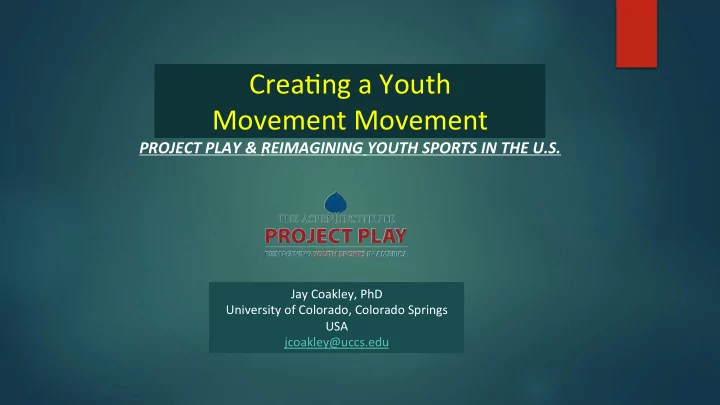

Crea%ng a Youth Movement Movement PROJECT PLAY & REIMAGINING YOUTH SPORTS IN THE U.S. Jay Coakley, PhD University of Colorado, Colorado Springs USA jcoakley@uccs.edu
Project Play: What must we do to enable all children to be physically ac%ve and healthy? hDps://www.aspenprojectplay.org/
Why Project Play in the U.S.? u U.S. children are heavier, rounder, weaker, less physically literate, and more sedentary today than in the past u Obesity rates for children and adults are higher in the US than any other wealthy, post-industrial nation u Inactivity is a primary factor in creating high costs related to health and undermining quality of life u Youth sports in the U.S. generally fail to inspire young people to be physically active past early adolescence
Exis%ng system of sport in the U.S. is built on an eli%st & exclusionary model Fragmented, incoherent
How are youth sports failing in the U.S. 1. Many young people are dropping out, burning out, or being injured out of exis%ng programs u over the past decade there has been a significant decline in par%cipa%on across many youth sports u Concussion and injury rates are increasing, and parents are increasingly concerned about physical safety 2. Access to par%cipa%on is limited for many young people due to increasing costs & “pay to play” programs 3. Programs are oIen organized to fit the interests and expecta%ons of adults more than children. 4. Programs increasingly emphasize high performance rather than inclusive, age-appropriate, & enjoyable experiences
The framework
Physical ac%vity is brain-ergizing
Challenges & Sources of Resistance u Crea%ng coopera%on among people from different sectors of society: health, medicine, sports, community recrea%on organiza%ons, schools, corpora%ons, public policy, families u Preven%ng people from high performance sport from domina%ng discussions & strategies u Conver%ng people who believe that “ God created sports in certain ways and thou shalt not change those sports ”
Physical Literacy: The foundational goal of Project Play As de fi ned in the United States via the work of Project Play The ability, confidence & desire to be physically ac%ve for life
Ability refers to competency in basic movement skills & an overall fitness that allows individuals to engage in a variety of games and activities. Abilities are best developed through a mix of informal play & intentional teaching of movement skills Abilities come in 3 major forms:
Locomotive abilities involve negotiating physical environments and taking the body from one point to the next. They include, but are not limited to: ➢ Walking ➢ Running ➢ Hopping ➢ Jumping ➢ Skipping ➢ Swimming If you have locomotive abilities you can enjoy track and field events, swimming, hiking, tag games, triathlons, jogging, racing … .
Object control abilities i nvolve controlling implements such as balls, hoops, racquets, sticks, etc by hand, foot, or other part of the body. They include, but are not limited to: ➢ Throwing ➢ Catching ➢ Kicking ➢ Striking ➢ Bouncing ➢ Dribbling If you have Object control abilities you can enjoy soccer, basketball, baseball & softball, football, tennis, ice & field hockey, lacrosse...
Body management abilities involve controlling and balancing the body while in stillness or in motion and are key to injury prevention. They include, but are not limited to: ➢ Bending and stretching ➢ Landing ➢ Rolling ➢ Twisting and turning ➢ Swinging and Climbing ➢ Lifting ➢ Dodging ➢ Falling If you have Body management abilities you can enjoy y oga, skateboarding, gymnastics, biking, rock climbing … ..
Confidence is knowing that you have the ability to play sports and enjoy other physical activities. Confidence is tied to context, and it is maximized in settings that are welcoming, age-appropriate, inclusive, and supportive.
Desire is the intrinsic enthusiasm for physical activity, whether in organized or unstructured formats, in traditional or alternative Desire is born in early positive sports. experiences that are fun, and it is nurtured by opportunities to be creative
hDp://plreport.projectplay.us/
8 Project Play Strategies to build Sport for All, Play for Life communities
1) Ask children what they want & observe what they do and enjoy in their physical activities ü Ac%on ü Personal involvement in the ac%on ü Controlled challenges ü Posi%ve, reaffirming rela%onships ü With peers ü With coaches
2) Reintroduce Free Play v Culture of childhood play has largely disappeared v Parental fears keep children inside v Fear of what might happen to their children v Fear of what groups of unsupervised children might do v Computer games have captured the interest of young people v Play is seen by many adults as a waste of %me
3 ) Encourage sport sampling and multiple sport participation Early specializa%on in one sport year round is not the way to create excellence or lifelong par%cipa%on in physical ac%vity § Research on Long Term Athle%c Development (LTAD) affirms this § Coaches of elite sports know this § USOC & nearly all NGBs now endorse the American Development Model
4) Revitalize accessible, local leagues < 10% of all young people
5) Think Small
6) Design for Development
7) Train All Coaches
8) Emphasize Prevention
What You Can Do: Model Communities • Convene local leaders from across sectors • Reflect on research reports • Do an audit of where you are as a community • Set shared agenda
Recommend
More recommend